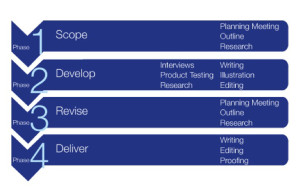ICG Documentation Development Process
We’ve been using this recipe for over 22 years. It’s worked successfully for most of Silicon Valley’s Fortune 500 companies.
We welcome the opportunity to show how it will work for your company!
Phase One: Scope
We initiate projects by meeting with our prospects and clients to set clear targets for the scope of work, the audience, the responsibilities, the schedule, and the cost. Specifically we identify:
- The engagement objective
- The engagement budget
- The engagement timeframe
- The documentation deliverables
- The documentation development environment and content-management system (e.g., FrameMaker, Author-it, MadCap, InDesign, XMetal, Adobe Creative Suite, MySQL, Filemaker, Omnigraffe, Microsoft Office Suite, ClearCase, QuarkXpress, Confluence, DITA, Joomia!)
- The project management methodology (e.g., waterfall, Agile, CCPM, BRM)
- The documentation delivery mechanism (e.g., print, web, mobile, wiki)
- The style guide to be used (we can recommend or develop a style guide if necessary)
- Any other engagement or documentation parameters
Once all parameters of the project are established, we develop a statement of work (SOW), and a preliminary outline for all documentation deliverables.
Phase Two: Development
Once the client agrees to the SOW and documentation outlines, we initiate development by:
- Identifying subject-matter experts (SMEs)
- Scheduling our attendance at the appropriate project management team meetings
- Collecting and reviewing background materials
We study the background materials, interview the engineers and marketing people, and operate the product ourselves. We often work directly from hardware schematics and software code.
We then initiate a first draft. As we write, we design and produce illustrations and layouts that simplify the text.
We make sure the English is clear, the organization is simple, the terminology is consistent, and the audience is sharply targeted.
Phase Three: Revision
All stakeholders review the first draft, and all edits and comments are incorporated into a second draft. An alpha test of the resulting documentation is conducted with the development group, and if applicable, a beta test with a sample of target users.
Phase Four: Delivery
The revision process is repeated until a final documentation set passes all requisite testing, and is signed off by our client.

